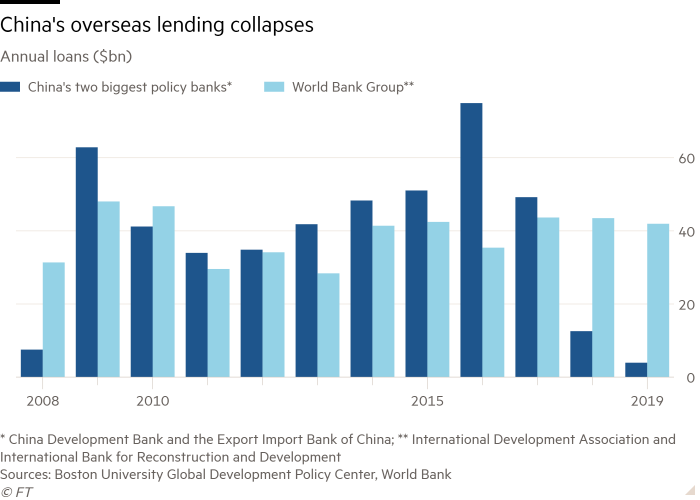
China has drastically curtailed the overseas lending programme of its two largest policy banks, after nearly a decade of ambitious growth which at its peak rivalled that of the World Bank, new research indicates.
Lending by the China Development Bank and the Export-Import Bank of China collapsed from a peak of $75bn in 2016 to just $4bn last year, according to data compiled by researchers at Boston University and seen by the Financial Times.
The sharp retrenchment comes as Beijing rethinks its Belt and Road Initiative, the signature scheme of China’s leader Xi Jinping that finances and builds roads, railways, ports and other infrastructure in mostly developing countries.
The BRI has attracted growing criticism around the world for weaknesses including lending to low-income countries with shaky finances and a lack of transparency or social and environmental impact studies on the projects financed.
Kevin Gallagher, director of the Boston University Global Development Policy Center, which compiled the data, said Beijing’s trade war with the US was also a factor in the dramatic shift.
“In 2018 and [20]19 there was so much uncertainty because of the trade war with the US, they may have wanted to keep dollar assets at home,” he said.

According to a recent report by the Overseas Development Institute, a think-tank, Beijing is now realising that its approach to lending is unsustainable.
“The old . . . model, whereby the interests of Chinese companies and local elites take precedence over the good of the borrowing country, which bears a disproportionate amount of the project failure risk, will become even more unsustainable amid countries’ reduced capacity to take on debt and risk,” the ODI report said.
China has three policy banks that drive infrastructure investment at home and overseas: the two banks covered by the Boston University survey and the Agricultural Development Bank. They can lend overseas on concessionary terms but more often lend at close to commercial rates of interest.
But the poor governance standards often associated with Chinese lending to BRI projects have contributed to a series of scandals and complaints by debtor countries.
In one recent example, Pakistan — one of the biggest recipients of BRI lending — alleged that Chinese companies inflated power project costs by billions of dollars; it is seeking to renegotiate repayment terms. Islamabad accused Chinese and local power companies of “malpractices” and exaggerating costs. Several big-ticket projects in Malaysia have also become mired in controversy.
Yu Jie, senior research fellow on China at Chatham House, the UK think-tank, said that state-owned enterprises and state-owned banks were shifting their resources to domestic rather than overseas projects. Beijing’s economic policies have changed in recent years from an emphasis on export-led growth to domestic investment and consumption.
“There will be far more stringent criteria on the commercial viability of projects,” Ms Yu said. “In the past it was more about using financial resources to extend China’s political influence. Now it will be more about commercial gains.”
She added that China faced “enormous . . . reputational damage” from the BRI: “Its expansive nature has alarmed the rest of the world and the government has been unable to come up with a transparent plan and explain its debt diplomacy.”
Public opinion in China is also a headwind to overseas lending, she said, as policymakers and the public have realised China needs to invest more in its health services, which had been tested by the coronavirus pandemic.
China’s lending has been concentrated in a relatively small number of countries, with 10 recipients making up 60 per cent of the total, according to the Boston University research. Loans to Venezuela, the largest recipient, took up more than 12.5 per cent, followed by Pakistan, Russia and Angola.
Projects financed were predominantly in transport and other infrastructure, mining and oil extraction, including pipelines, and power generation and transmission.
Of 858 loans identified by the Boston researchers, 124 were for projects in nationally protected areas, 261 were within critical habitats and 133 were within indigenous peoples’ lands.




















